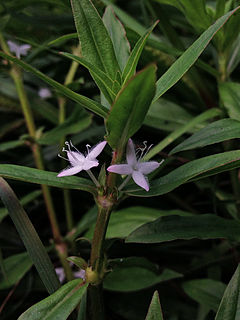
Diodia is a genus of flowering plants in the family Rubiaceae. It was described by Carl Linnaeus in 1753. The genus is found from southern and eastern United States, South America, Central America, Mexico, the West Indies and tropical Africa.
Belonophora ongensis is a species of flowering plant in the family Rubiaceae. It is native to Gabon and Cameroon. Its natural habitat is subtropical or tropical moist lowland forests. It is threatened by habitat loss.
Belonophora is a genus of flowering plants in the family Rubiaceae. It is found in Tropical Africa from Senegal east to Sudan and south to Angola. It was described by Joseph Dalton Hooker in 1873.
Belonophora talbotii is a species of flowering plant in the family Rubiaceae. It is found in Nigeria, Cameroon and Gabon. It is threatened by habitat loss.
Calochone is a genus of flowering plants in the family Rubiaceae. The genus is found in Cameroon, Gabon, Cabinda Province, Republic of the Congo, and Democratic Republic of the Congo.

Mimusops is a genus of plants in the family Sapotaceae described as a genus by Linnaeus in 1753.
Pausinystalia is a largely African genus of plant in the family Rubiaceae. As of the present time Pausinystalia contains the following 5 species:

Puelia is a genus of African grasses, the only genus in the tribe Atractocarpeae. It belongs to the subfamily Puelioideae, one of the early-diverging lineages in the grasses, but used to be considered a bamboo genus.
Corynanthe is a genus of flowering plants in the family Rubiaceae. It currently contains three accepted species, native to Africa.
Cuviera is a genus of flowering plants in the family Rubiaceae native to tropical Africa. It was originally described by Augustin Pyramus de Candolle in 1807 and is named after the French naturalist Georges Cuvier.
Batopedina is a genus of flowering plants in the family Rubiaceae. It was described by Bernard Verdcourt in 1953. The genus is found in Burkina Faso, Ghana, D.R.Congo, and Zambia.
Belonophora coffeoides is a species of flowering plant in the family Rubiaceae. It is found in Tropical Africa. It is the type species of the genus Belonophora.
Belonophora wernhamii is a species of flowering plant in the family Rubiaceae. It is found in Nigeria and Cameroon.
Brenania is a genus of flowering plants in the family Rubiaceae. It is found from Nigeria to Cameroon, Gabon, Cabinda, Central African Republic, Congo, and D.R.Congo. The genus was described in 1958 and contained only the type species Brenania spathulifolia.

Cubanola is a genus of flowering plants in the family Rubiaceae, with large, showy, hanging flowers. They are endemic to the Dominican Republic and eastern Cuba.
Craterispermum is a genus of flowering plants in the family Rubiaceae. It contains 16 species that occur in tropical Africa and Seychelles. It is the only genus in the tribe Craterispermeae, of which the divergence time is estimated at 34.8 million years ago.
Chamaepentas is a genus of flowering plants in the family Rubiaceae. It is native to tropical Africa.
Preussiodora is a genus of plants in the family Rubiaceae. It contains only one species, Preussiodora sulphurea, native to central Africa.
Dendrosipanea is a genus of flowering plants in the family Rubiaceae. The genus is found in Brazil and Venezuela.
Colletoecema is a genus of flowering plants in the family Rubiaceae. It is the only genus in the tribe Colletoecemateae. The 3 species are found from west-central tropical Africa to Angola.



